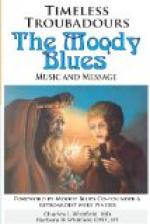instruct his joglar Cabra; Guiraut upbraids
this performer for his ignorance, and details a long
series of legends and poems which a competent joglar
ought to know. Guiraut de Calanso wrote an imitation
of this diatribe. The best known of the Catalonian
troubadours is Raimon Vidal of Besadun, both for his
novelas and also for his work on Provencal
grammar and metre, Las rasos de trobar,[33]
which was written for the benefit of his compatriots
who desired to avoid solecisms or mistakes when composing.
“For as much as I, Raimon Vidal, have seen and
known that few men know or have known the right manner
of composing poetry (trobar) I desire to make this
book that men may know and understand which of the
troubadours have composed best and given the best
instruction to those who wish to learn how they should
follow the right manner of composing.... All Christian
people, Jews, Saracens, emperors, princes, kings,
dukes, counts, viscounts, vavassors and all other
nobles with clergy, citizens and villeins, small and
great, daily give their minds to composing and singing....
In this science of composing the troubadours are gone
astray and I will tell you wherefore. The hearers
who do not understand anything when they hear a fine
poem will pretend that they understand perfectly...
because they [123] think that men would consider
it a fault in them if they said that they did not
understand.... And if when they hear a bad troubadour,
they do understand, they will praise his singing because
they understand it; or if they will not praise, at
least they will not blame him; and thus the troubadours
are deceived and the hearers are to blame for it.”
Raimon Vidal proceeds to say that the pure language
is that of Provence or of Limousin or of Saintonge
or Auvergne or Quercy: “wherefore I tell
you, that when I use the term Limousin, I mean all
those lands and those which border them or are between
them.” He was apparently the first to use
the term Limousin to describe classical Provencal,
and when it became applied to literary Catalonian,
as distinguished from pla Catala, the vulgar
tongue, the result was some confusion. Provencal
influence was more permanent in Catalonia than in any
other part of Spain; in 1393, the Consistorium of
the Gay saber was founded in imitation of the
similar association at Toulouse. Most of the troubadour
poetical forms and the doctrines of the Toulouse Leys
d’Amors were retained, until Italian influence
began to oust Provencal towards the close of the fifteenth
century.
On the western side of Spain, Provencal influence evoked a brief and brilliant literature in the Galician or Portuguese school. Its most [124] brilliant period was the age of Alfonso X. of Castile, one of its most illustrious exponents, and that of Denis of Portugal (1280-1325). The dates generally accepted for the duration of this literature are 1200-1385; it has left to us some 2000 lyric poems, the work of more than 150 poets, including four kings and a number of nobles of high rank. French and Provencal culture had made its way gradually and by various routes to the western side of the Spanish peninsula.




